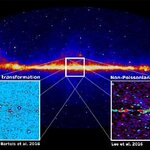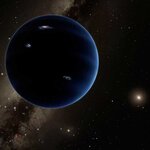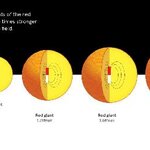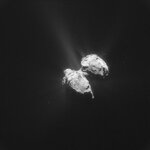Space

The undefined blanket term "dark matter", what must exist in the universe to account for missing mass, is invoked for just about everything, and so a lot of claims are made affirming they have evidence for it. But one claim, that bursts of gamma rays are such, is instead other astrophysical phenomena such as fast-rotating stars called millisecond pulsars, according to two new studies in Physical Review Letters.
Previous papers suggested that gamma rays coming from the dense region of space in the inner Milky Way galaxy could be caused when invisible dark matter particles collide. But…
I don't think we will ever. Or at least not in the foreseeable near future. It's a bit like asking "When will we colonize Antarctica". or "When will we colonize the sea bed". But much harder to colonize Mars than either of those.
COMPARISON OF COLONIES ON MARS WITH COLONIES ON SEA BED OR IN ANTARCTICA
Mars at the equator is the same temperature as Antarctica on Earth, but actually gets far colder than Antarctica at night, gets so cold that it's below the freezing point for dry ice.
It has the same problem of no oxygen to breathe, as the sea bed. If living on the sea bed, then breathable…

Everyone has started to call this new proposed planet X: "Planet nine" as in the original announcement. Even Wikipedia has titled its article on it "Planet Nine". But it's a poor name for a planet if you think about it. Why not just call it "Planet X"? Or find some new name, like Nemesis and Tyche as was done for previous planet X candidates. None of the previous candidates for Planet X were called Planet + some number, and with good reason. There is no way that we can know it will be planet 9.
What if other planets are found closer to the sun? There's another proposed "Planet X…
As someone who is keen on astronomy, I am of course keen on the Thirty Meter telescope myself. And I've heard those arguments of the astronomers, about how it is an ideal site for astronomy, about the value of the astronomy that can be done with this telescope and so on. But I've also heard the other side too.
There are many telescopes on the summit already, so it's not like they are saying not to build telescopes at all up there.
SIZE OF THE PROPOSED TELESCOPE
What you might not realize at first is quite how huge it is - it's difficult to get a sense of scale from the images:
It's higher…

Just a short post, since I do articles here from time to time to reassure those who worry about collisions with Earth for every new discovery. This new planet X is not even proved to exist yet. But if it is - it orbits way beyond Neptune. It is no more of a threat to us than Neptune was when it was discovered in the nineteenth century. Rather it's fun and exiting, and we could learn new things from it if it exists.
Artist’s rendering of what Planet Nine might look like. Caltech/R. Hurt (IPAC)
This shows its orbit compared to the rest of the solar system:
(DATA) JPL; BATYGIN AND BROWN/…

Caltech researchers have found evidence of a giant planet tracing a bizarre, highly elongated orbit in the outer solar system. The object, which the researchers have nicknamed Planet Nine, has a mass about 10 times that of Earth and orbits about 20 times farther from the sun on average than does Neptune (which orbits the sun at an average distance of 2.8 billion miles). In fact, it would take this new planet between 10,000 and 20,000 years to make just one full orbit around the sun.
The researchers, Konstantin Batygin and Mike Brown, discovered the planet's existence through mathematical…
Actually though most of the stories say it is the first flower to bloom in space, and Scott Kelly tweeted it as such, it turns out that there have been several flowers grown in space before, most recently in 2012, but the first such was way back in 1982. It does seem to be the first Zinnia to flower in space.
Here is Scott Kelly's tweet
"First ever flower grown in space makes its debut! #SpaceFlower #zinnia#YearInSpace"
Here is the CNN news story about it, where Lin Taylor mentions an earlier flower in space. Astronauts grow first zinnia flower in space - CNN.…

Science is advancing rapidly. We are eradicating diseases, venturing further into space and discovering a growing zoo of subatomic particles. But cosmology – which is trying to understand the evolution of the entire universe using theories that work well to describe other systems – is struggling to answer many of its most fundamental questions.
We still have no idea what the vast majority of the universe is made of. We struggle to understand how the Big Bang could suddenly arise from nothing or where the energy for “inflation”, a very short period of rapid growth in the early universe, came…

Strong magnetic fields discovered have been discovered in a majority of stars. An international group of astronomers led by the University of Sydney has discovered strong magnetic fields are common in stars, not rare as previously thought, using data from NASA's Kepler mission.
The team found that stars only slightly more massive than the Sun have internal magnetic fields up to 10 million times that of the Earth.
Stars like the Sun puff up and become red giants towards the end of their
lives. The red giants ('old' Suns) of the same mass as the Sun do not show
strong magnetic…

It has been a busy year for Solar System exploration – and particularly our galactic neighborhoods small icy bodies. Comets, asteroids, Kuiper Belt Objects and planetary satellites have all been in the news – from stunning images of comet 67P Churyumov-Gerasimenko at the start of the year, to the recent close-up of Saturn’s moon, Enceladus, via Ceres and Pluto.
Early January was a continuation of the stream of data from Rosetta, as comet 67P drew closer to the sun. Images were released of jets emanating from the sun-facing surface, from which it could be seen that sublimation of water-ice…